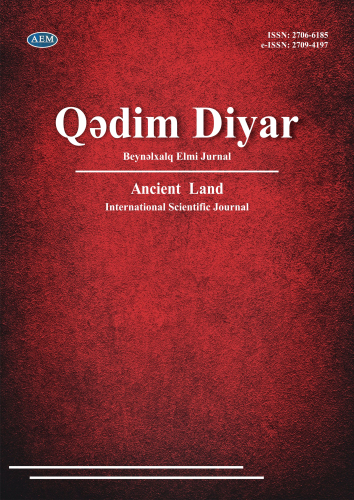DOI: 10.36719/2706-6185/02/21-41
Ярослав Валентинович Пилипчук
Национальный Педагогический Университет им. М.П.Драгоманова
кандидатісторичних наук
АБХАЗСКОЕ КНЯЖЕСТВО ШАРВАШИДЗЕ И АБАЗИНЫ
МЕЖДУ ТЮРКАМИ И РОССИЙСКОЙ ИМПЕРИЕЙ
Резюме
Статья посвящена истории взаимоотношений абхазов и абазин с мингрелами, тюркским миром и русскими. Абхазский мтаварист сложился на основе цхумского эриставаризма. В течение XV века - первой половины XVII века. Абхазия входила в состав мегрельских княжеств Сабедиано и Одиши. Регионом фактически правила грузинская династия Шарвашидзе. В течение XVII в. Абхазы оказали давление на мегрелов и продвинули свою границу к реке Ингури. Они принимали активное участие в междоусобицах в Мингрелии. В XVIII в. Абхазы оказывали давление на османские владения в Грузии. В XVIII в. Абхазия, несмотря на формальную вассальную зависимость от Османской империи, была практически независимым княжеством, которое в свое время было разделено на ряд уделов и свободных обществ. Удельное княжество Самурзакан имело смешанный (абхазско-мегрельский) этнический состав населения. Самым могущественным абхазским правителем был Келешбей, который лавировал между османами и Российской империей, фактически сохраняя независимость. Он объединил несколько судеб в единое государство. Сефербей (Георгий Шарвашидзе) и Хамутбей (Михеил Шарвашидзе) на самом деле были русскими демонстрантами, не нашедшие поддержки в народе. Однако Михаил Шарвашидзе пытался проводить самостоятельную политику. Он боролся с мегрелами Дадиани за контроль над Самурзакано и укрепил власть над горными свободными обществами Абхазии. Во время Крымской войны лавировал между османами и романовыми. Широкой поддержкой в народе пользовались и опальные Асланбей и Гасанбей. Абхазы несколько раз восставали против русских в XIX веке. Это часто было связано с наступлением русских на права абхазских князей и горских вольных обществ. Главными инициаторами противостояния с русскими были цебельдинские князья Маршания. Горные общины Цебельды, Псху и Даля обезлюдели в результате абхазского махаджирства. Южные абазины-садзы тяготели к Абхазии и зависели от нее. Они поддержали Асланбея в его борьбе против русских. Они также были прочно связаны с убыхами и черкесскими племенами, принимавшими участие в Кавказской войне. Часть черкесских племен XVIII века были ассимилированы абазинами. Северные абазины составляли свободные общества. Попытки крымских гераев подчинить их себе не увенчались успехом. Присутствие ногайцев и тюрков на абазинских землях было эпизодическим. В XVI-XVII вв. Северные абазины были подданными Большой и Малой Кабарды, а также отправляли посольства к русским в Москву и Терский город. Они были лояльны к российским властям и реагировали на ущемление прав переселенцев в горы. Южные абазины (джигеты) с 40-х годов XIX века стали подданными Российской империи.
Ключевые слова: Абхазское княжество, абхазы, абазины, Шарвашидзе, Маршаниа, Одиши, Сабедиано, мингрелы, турки, Османская империя, Российская империя, русские
Yaroslav Valentinovich Pilipchuk
National Pedagogical University M.P.Dragomanova
candidate of historical sciences
Abkhaz principality of Sharvashidze and Abazins Between
the Turks and the Russian Empire
Abstract
This paper is devoted to the history of the relationship of Abkhazians and Abazines with the Mingrels, Turkic world and the Russians. Abkhazian mtavarist developed on the basis of the Tskhum eristavarist. During the XV century - the first half of the XVII century. Abkhazia was an integral part of the Mingrel principalities of Sabediano and Odishi. The region was actually ruled by the Georgian Sharvashidze dynasty. During the XVII century. Abkhazians put pressure on the Mingrels and advanced their border to the Enguri River. They took an active part in the strife in Mingrelia. In the XVIII century. Abkhazians put pressure on the Ottoman possessions in Georgia.in XVIII cebtury. Abkhazia despite the formal vassalage from the Ottoman Empire was practically an independent principality, which at one time was divided into a number of destinies and free societies. The specific principality of Samurzakan had a mixed (Abkhazs and Mingrels) ethnic composition of the population. The most powerful Abkhaz ruler was Keleshbey, who maneuvered between the Ottomans and the Russian Empire in fact maintained independence. He combined several destinies into a single state. Seferbey (Giorgi Sharvashidze) and Hamutbey (Mikheil Sharvashidze) were in fact Russian demonstrators, who did not find support among the people. However, Mikheil Sharvashidze tried to pursue an independent policy. He fought with the Mingrel Dadiani for control of Samurzakano and strengthened power over the mountainous free societies of Abkhazia. During the Crimean War, he maneuvered between the Ottomans and the Romanovs. The disgraced Aslanbey and Hasanbey also enjoyed wide support among the people. The Abkhazian rebelled against the Russians several times in the XIX century. This was often associated with the offensive of the Russians on the rights of the Abkhazian princes and the mountain free societies. The main initiators of the confrontation with the Russians were the Tsebeldin princes Marshania. The mountain communities of Tsebelda,Pskhu and Dal became deserted as a result of Abkhazian mahajirism. Southern Abazins-Sadzes gravitated towards Abkhazia and depended on it. They supported Aslanbey in his struggle against the Russians.They were also strongly associated with the Ubykhs and the Circassian tribes who took part in the Caucasian war. Part of the Circassian tribes of the XVIII century were assimilated abazins. Northern Abaza made up free societies. The attempts of the Crimean Gherays to subjugate them to themselves were unsuccessful. The presence of Nogays and Turks in the Abazin lands was episodic. In the XVI - XVII centuries. The northern Abazins were subjects of Greater and Lesser Kabarda, and they also sent embassies to the Russians in Moscow and Tersky town. They were loyal to the Russian authorities and reacted to the infringement of rights migration to the mountains. Southern Abazins (Jigets) since the 40-ies of XIX century they became subjects of the Russian Empire.
Keywords: Abkhazian principality, Abkhazians, Abazins, Sharvashidze, Marshania, Turks, Ottoman Empire, Odishi, Sabeianom Mingrels, Russian Empire, Russians

